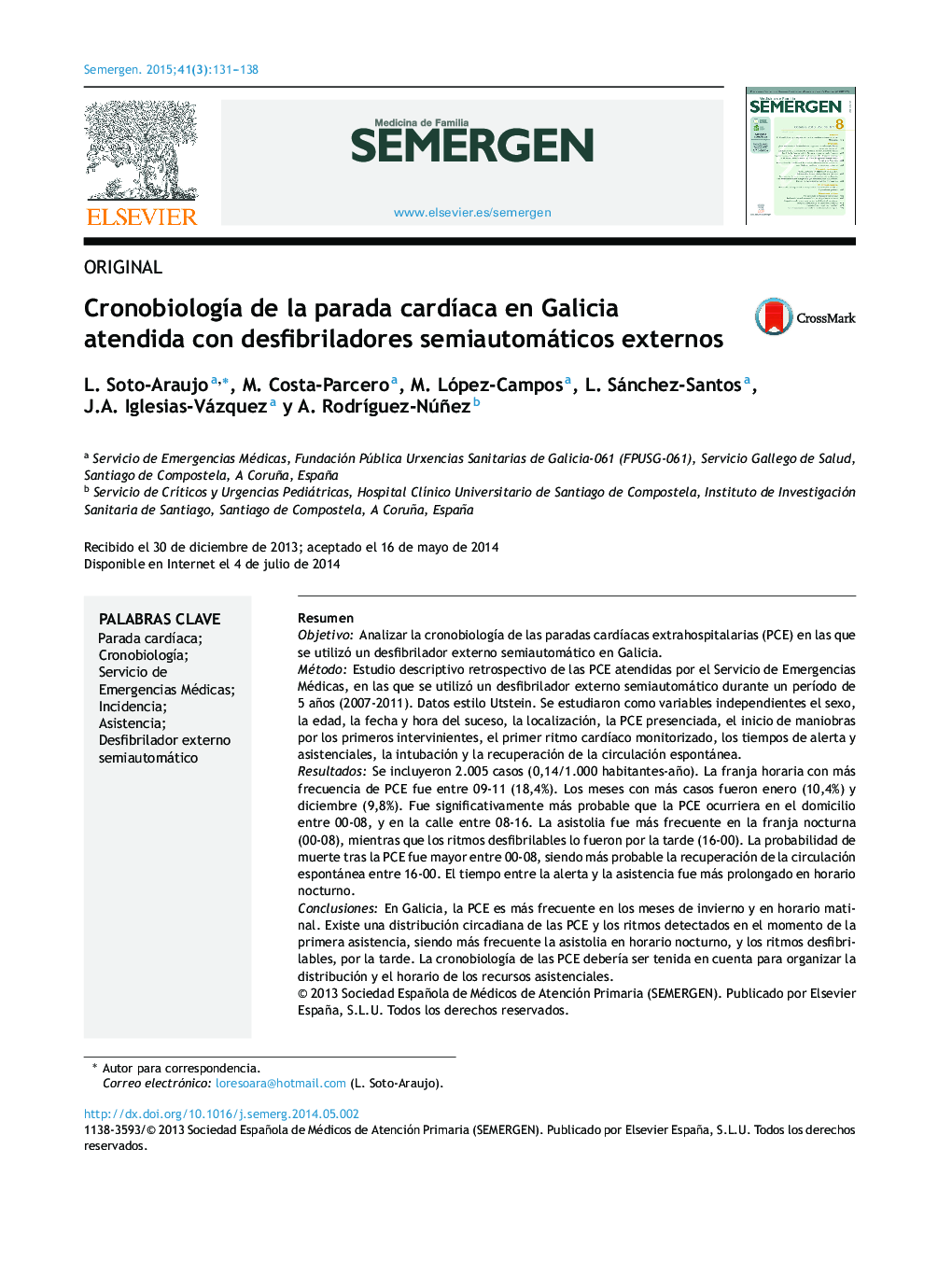| کد مقاله | کد نشریه | سال انتشار | مقاله انگلیسی | نسخه تمام متن |
|---|---|---|---|---|
| 3834731 | 1247332 | 2015 | 8 صفحه PDF | دانلود رایگان |

ResumenObjetivoAnalizar la cronobiología de las paradas cardíacas extrahospitalarias (PCE) en las que se utilizó un desfibrilador externo semiautomático en Galicia.MétodoEstudio descriptivo retrospectivo de las PCE atendidas por el Servicio de Emergencias Médicas, en las que se utilizó un desfibrilador externo semiautomático durante un período de 5 años (2007-2011). Datos estilo Utstein. Se estudiaron como variables independientes el sexo, la edad, la fecha y hora del suceso, la localización, la PCE presenciada, el inicio de maniobras por los primeros intervinientes, el primer ritmo cardíaco monitorizado, los tiempos de alerta y asistenciales, la intubación y la recuperación de la circulación espontánea.ResultadosSe incluyeron 2.005 casos (0,14/1.000 habitantes-año). La franja horaria con más frecuencia de PCE fue entre 09-11 (18,4%). Los meses con más casos fueron enero (10,4%) y diciembre (9,8%). Fue significativamente más probable que la PCE ocurriera en el domicilio entre 00-08, y en la calle entre 08-16. La asistolia fue más frecuente en la franja nocturna (00-08), mientras que los ritmos desfibrilables lo fueron por la tarde (16-00). La probabilidad de muerte tras la PCE fue mayor entre 00-08, siendo más probable la recuperación de la circulación espontánea entre 16-00. El tiempo entre la alerta y la asistencia fue más prolongado en horario nocturno.ConclusionesEn Galicia, la PCE es más frecuente en los meses de invierno y en horario matinal. Existe una distribución circadiana de las PCE y los ritmos detectados en el momento de la primera asistencia, siendo más frecuente la asistolia en horario nocturno, y los ritmos desfibrilables, por la tarde. La cronobiología de las PCE debería ser tenida en cuenta para organizar la distribución y el horario de los recursos asistenciales.
ObjectiveTo analyze the chronobiological variations of out-hospital cardiac arrest in which an automated external defibrillator was used in Galicia.MethodDescriptive retrospective study of the cardiac arrest attended by the Emergency Medical Service in which an automated external defibrillator was in use during a period of 5 years (2007-2011). An Utstein style database was used. The sex, age, date and hour of the event, location, cardiac arrest attended, beginning of resuscitation by the professional, first monitored rhythm, emergency team activation time and care, endotracheal intubation, and recovery of spontaneous circulation were studied as independent variables.ResultsA total of 2,005 cases (0.14/1,000 population-year) was recorded. Time slot with more frequency of cardiac arrest: between 09-11 hrs (18.4%). Months with more cases: January (10.4%) and December (9.8%). It was significantly more probable that the cardiac arrest occurred in the home between 00-08 hrs, and in the street between 08-16 hrs. Asystole was more frequent in the night period (00-08 hrs), whereas the shockable rhythm was in the evening (16-00 hrs). There is more probability of death after cardiac arrest between 00-08 hrs, with recovery of spontaneous circulation being more probable between 16-00 hrs. The time between the emergency team activation and time care was longer in night schedule.ConclusionsIn Galicia, cardiac arrest is more frequent in the winter months and in morning schedule. There is a circadian distribution of the cardiac arrest and the rhythm detected at the time of the first assistance, with asystole being more common in night schedule and the shockable rhythm in the evening. The chronobiology of the cardiac arrest should be taken into account in order to organize the distribution and the schedule of the healthcare resources.
Journal: SEMERGEN - Medicina de Familia - Volume 41, Issue 3, April 2015, Pages 131–138